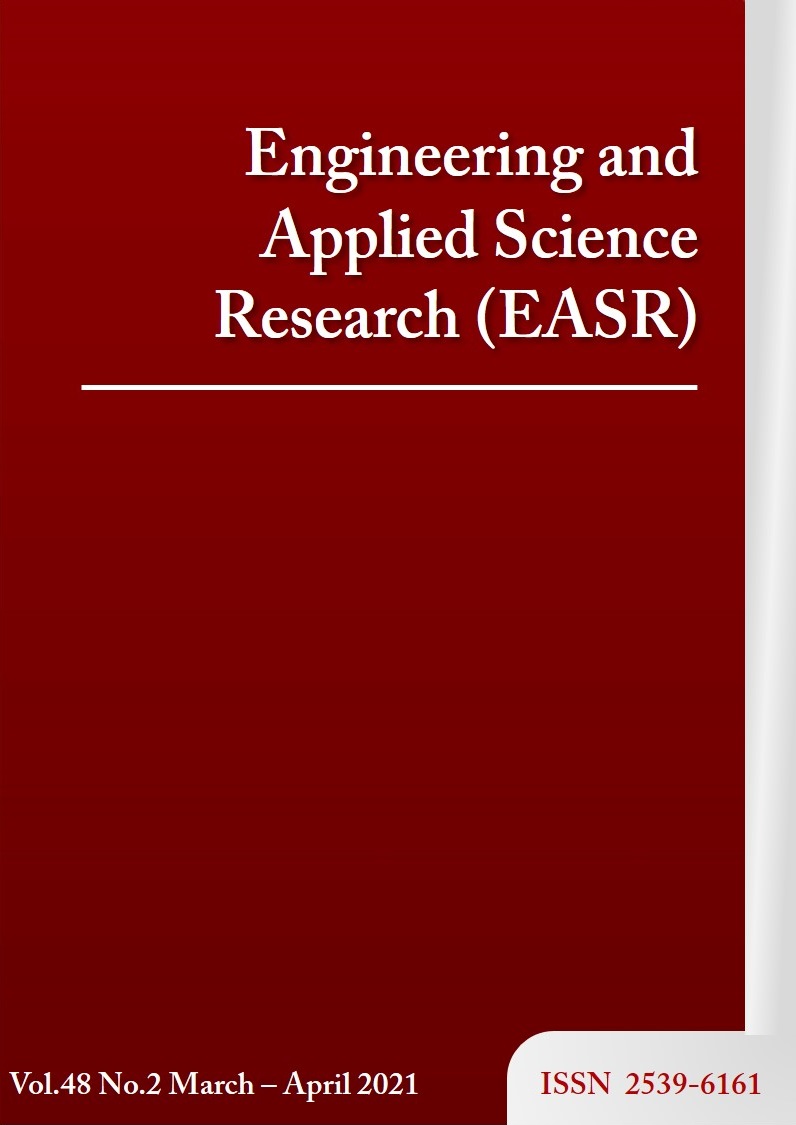Application of a rainfall-runoff model for flood generation in the Huai Sangka catchment, Thailand
Main Article Content
Abstract
Estimation of the rainfall-runoff relationship is essential for solving and managing water resources. This paper presents the use of an event-based rainfall-runoff model built with HEC-HMS version 4.3 to simulate runoff in the Huai Sangka catchment (193 km2), a small agricultural watershed. The rainfall-runoff model was conducted by a semi-distributed modelling approach, where parameter values of sub-basins were estimated based on spatial and temporal data such as topography, land use, soil and climatic variables. The modelling approach includes Soil Conservation Service (SCS) Curve Number, SCS unit hydrograph and Muskingum routing methods for simulating losses, runoff transformation, and routing in the rainfall-runoff system, respectively. The rainfall-runoff model was used to simulate runoff with corresponding to four extreme rainstorm events (in September 2007, September 2008, August 2011 and July 2017). The present study aimed at testing the applicability of the modelling approach to ungauged basins. Thus, only travel time parameter K of the Muskingum routing method was adjusted to achieve reasonable reproductions of major flood hydrographs. The other parameters, which were initially estimated from the spatial data, were remained constant. On the basis of event-based runoff simulation results, the largest percentage error in peak was 12.96%, considered satisfactory. The comparison of the observed and simulated hydrographs confirmed the reliable performances of the rainfall-runoff model with NSE values, ranging between 0.61 and 0.74 and with RSR values, ranging between 0.51 and 0.57 for the selected rainstorm events. Thus, the model was considered suitable for flood simulations in the study catchment. Furthermore, it was found that the travel time parameter K is strongly related to physical characteristics of channels. In summary, the modelling approach is applicable to ungauged watersheds since model parameters can be estimated on the basis of physical characteristics.
Article Details
This work is licensed under a Creative Commons Attribution-NonCommercial-NoDerivatives 4.0 International License.
References
Subramanya K. Engineering hydrology. Boston: McGraw-Hill; 2007.
Sivapalan M, Takeuchi K, Franks SW, Gupta VK, Karambiri H, Lakshmi V, et al. IAHS decade on predictions in ungauged basins (PUB), 2003–2012: shaping an exciting future for the hydrological sciences. Hydrol Sci J. 2003;48:857-80.
Verma AK, Jha MK, Mahana RK. Evaluation of HEC-HMS and WEPP for simulating watershed runoff using remote sensing and geographical information system. Paddy Water Environ. 2010;8:131-44.
Singh VP, Vieux BE. Distributed hydrologic modeling using GIS. Dordrecht: Springer Netherlands; 2001.
Chowdary VM, Desai VR, Gupta M, Jeyaram A, Murthy YVNK. Runoff simulation using distributed hydrological modeling approach, remote sensing and GIS techniques watershed: a case study from an Indian agricultural. Int Arch Photogramm Remote Sens Spatial Inf Sci. 2012;203-7.
Beven KJ. Rainfall-runoff modelling: the primer. 2nd ed. New York: John Wiley & Sons Inc; 2012.
Hapuarachchi HAP, Wang QJ, Pagano TC. A review of advances in flash flood forecasting. Hydrol Process. 2011;25:2771-84.
Arnold JG, Srinivasan R, Muttiah RS, Williams JR. Large area hydrologic modeling and assessment part I: model development. J Am Water Resour As. 1998;34:73-89.
Moore R, Cole S, Bell VA, Jones D. Issues in flood forecasting: ungauged basins, extreme floods and uncertainty. In: Tchiguirinskaia L, Thein KNN, Hubert P, editors. Frontiers in Flood Research. Wallingford: IAHS Publication; 2006. p. 103-22.
Yadav M, Wagener T, Gupta H. Regionalization of constraints on expected watershed response behavior for improved predictions in ungauged basins. Adv Water Resour. 2007;30:1756-74.
Razavi T, Coulibaly P. Streamflow prediction in ungauged basins: review of regionalization methods. J Hydrol Eng. 2013;18:958-75.
Abdulkareem JH, Pradhan B, Sulaiman WNA, Jamil NR. Review of studies on hydrological modelling in Malaysia. Model Earth Syst Environ. 2018;4:1577-605.
Feldman AD. Hydrologic modeling system (HEC-HMS). Techical reference manual. California: US Army Corps of Engineers; 2000.
Zelelew D, Melesse A. Applicability of a spatially semi-distributed hydrological model for watershed scale runoff estimation in Northwest Ethiopia. Water. 2018;10:923.
Halwatura D, Najim MMM. Application of the HEC-HMS model for runoff simulation in a tropical catchment. Environ Model Softw. 2013;46:155-62.
Nandalal HK, Ratmayake UR. Event based modeling of a watershed using HEC-HMS. Engineer: Journal of the Institution of Engineers, Sri Lanka. 2010;43:28-37.
Tassew BG, Belete MA, Miegel K. Application of HEC-HMS model for flow simulation in the Lake Tana basin: the case of Gilgel Abay catchment, upper Blue Nile basin, Ethiopia. Hydrology. 2019;6:1-21.
Marchi L, Borga M, Preciso E, Gaume E. Characterisation of selected extreme flash floods in Europe and implications for flood risk management. J Hydrol. 2010;394:118-33.
National Resources Conservation Service (NRCS) [Internet]. Part 630 Hydrology National Engineering Handbook; 2019 [updated 2019 May; cited 2020 Jun 17]. Available from: https://www.nrcs.usda.gov/wps/portal/ nrcs/site/national/home/.
Song X, Kong F, Zhu Z. Application of Muskingum routing method with variable parameters in ungauged basin. Water Sci Eng. 2011;4:1-12.
Krause P, Boyle DP, Bäse F. Comparison of different efficiency criteria for hydrological model assessment. Adv Geosci. 2005;5:89-97.
Moriasi DN, Gitau MW, Pai N, Daggupati P. Hydrologic and water quality models: performance measures and evaluation criteria. Trans ASABE. 2015;58:1763-85.
Yu D, Xie P, Dong X, Hu X, Liu J, Li Y, et al. Improvement of the SWAT model for event-based flood simulation on a sub-daily timescale. Hydrol Earth Syst Sci. 2018;22:5001-19.
Lohpaisankrit W, Meon G, Tingsanchali T. A framework of integrated hydrological and hydrodynamic models using synthetic rainfall for flash flood hazard mapping of ungauged catchments in tropical zones. Proc IAHS. 2016;373:183-7.
Maggioni V, Massari C. On the performance of satellite precipitation products in riverine flood modeling: a review. J Hydrol. 2018;558:214-24.
Fread DL. Flow routing. In: Maidment DR, editor. Handbook of hydrology. New York: McGraw-Hill; 1993. p. 1-30.
Yoo C, Lee J, Lee M. Parameter estimation of the Muskingum channel flood-routing model in ungauged channel reaches. J Hydrol Eng. 2017;22:5017005.
Tewolde MH, Smithers JC. Flood routing in ungauged catchments using Muskingum methods. Water SA. 2006;32(3):379-88.
Rosbjerg D, Blöschl G, Burn DH, Castellarin A, Croke B, Di Baldassarre G, et al. Prediction of floods in ungauged basins. In: Blöschl G, Sivapalan M, Wagener T, Viglione A, Savenije H, editors. Runoff prediction in ungauged basins. Cambridge: Cambridge University Press; 2013. p. 189-226.



